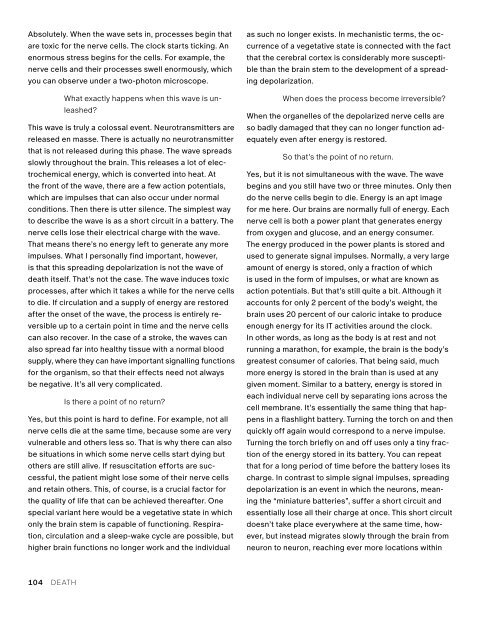Create successful ePaper yourself
Turn your PDF publications into a flip-book with our unique Google optimized e-Paper software.
Absolutely. When the wave sets in, processes begin that<br />
are toxic for the nerve cells. The clock starts ticking. An<br />
enormous stress begins for the cells. For example, the<br />
nerve cells and their processes swell enormously, which<br />
you can observe under a two-photon microscope.<br />
What exactly happens when this wave is unleashed?<br />
This wave is truly a colossal event. Neurotransmitters are<br />
released en masse. There is actually no neurotransmitter<br />
that is not released during this phase. The wave spreads<br />
slowly throughout the brain. This releases a lot of electrochemical<br />
energy, which is converted into heat. At<br />
the front of the wave, there are a few action potentials,<br />
which are impulses that can also occur under normal<br />
conditions. Then there is utter silence. The simplest way<br />
to describe the wave is as a short circuit in a battery. The<br />
nerve cells lose their electrical charge <strong>with</strong> the wave.<br />
That means there’s no energy left to generate any more<br />
impulses. What I personally find important, however,<br />
is that this spreading depolarization is not the wave of<br />
death itself. That’s not the case. The wave induces toxic<br />
processes, after which it takes a while for the nerve cells<br />
as such no longer exists. In mechanistic terms, the occurrence<br />
of a vegetative state is connected <strong>with</strong> the fact<br />
that the cerebral cortex is considerably more susceptible<br />
than the brain stem to the development of a spreading<br />
depolarization.<br />
When does the process become irreversible?<br />
When the organelles of the depolarized nerve cells are<br />
so badly damaged that they can no longer function adequately<br />
even after energy is restored.<br />
So that’s the point of no return.<br />
Yes, but it is not simultaneous <strong>with</strong> the wave. The wave<br />
begins and you still have two or three minutes. Only then<br />
do the nerve cells begin to die. Energy is an apt image<br />
for me here. Our brains are normally full of energy. Each<br />
nerve cell is both a power plant that generates energy<br />
from oxygen and glucose, and an energy consumer.<br />
The energy produced in the power plants is stored and<br />
used to generate signal impulses. Normally, a very large<br />
amount of energy is stored, only a fraction of which<br />
is used in the form of impulses, or what are known as<br />
action potentials. But that’s still quite a bit. Although it<br />
a few minutes. If blood flow to the brain is not restored,<br />
all 86 billion of our neurons will eventually be completely<br />
discharged and eventually so poisoned that they will die.<br />
What does dying feel like? What do we know<br />
about it? You speak of an enormous wave.<br />
People also talk about a final great display of<br />
fireworks …<br />
The reports of patients who were resuscitated and<br />
survived are the only things we can rely on. A patient lies<br />
there, unconscious, and appears to be dead although<br />
that is not yet the case. Their heart no longer beats but<br />
their nerve cells are still alive. Around 15 percent of people<br />
who are resuscitated have a conscious experience<br />
during this period. There are various speculations about<br />
what might be responsible for near-death experiences.<br />
Such as?<br />
A relatively interesting thought is that there may be a<br />
surge of activity in the initial phase, a final flare-up, so to<br />
speak, before the spontaneous electrical activity of the<br />
brain comes to a halt. This surge of activity might have<br />
something to do <strong>with</strong> near-death experiences. What is<br />
migraine auras, however, also describe a type of tunnel<br />
vision and/or bright lights. The source of the aura is a<br />
wave, which is very similar to what occurs in a stroke or<br />
in the process of dying.<br />
Which phenomena are considered to be neardeath<br />
experiences?<br />
Notable features of near-death experiences include a<br />
sense of simultaneity, a sense of being in multiple places<br />
at essentially the same time, and the ability to be of different<br />
ages at the same time. That would fit in well <strong>with</strong><br />
a coordinated short-term process in the brain by which<br />
a great many nerve cells are – more or less simultaneously<br />
– activated and call up our (stored) memories at<br />
nearly the same time. A look back in time, when your life<br />
seems to flash before your eyes. Other phenomena include<br />
out-of-body experiences, although these can also<br />
be triggered in other contexts, such as during epileptic<br />
seizures or by magnetic stimulation of certain regions of<br />
the brain.<br />
To what extent are images like the white tunnel<br />
influenced by cultural and religious ideas?<br />
to die. If circulation and a supply of energy are restored<br />
after the onset of the wave, the process is entirely reversible<br />
up to a certain point in time and the nerve cells<br />
can also recover. In the case of a stroke, the waves can<br />
also spread far into healthy tissue <strong>with</strong> a normal blood<br />
supply, where they can have important signalling functions<br />
for the organism, so that their effects need not always<br />
be negative. It’s all very complicated.<br />
accounts for only 2 percent of the body’s weight, the<br />
brain uses 20 percent of our caloric intake to produce<br />
enough energy for its IT activities around the clock.<br />
In other words, as long as the body is at rest and not<br />
running a marathon, for example, the brain is the body’s<br />
greatest consumer of calories. That being said, much<br />
more energy is stored in the brain than is used at any<br />
given moment. Similar to a battery, energy is stored in<br />
also important is that different regions of the brain can<br />
be in various stages of the process of dying. One region<br />
might already show a spreading depolarization, whereas<br />
another might not yet be affected. Another possibility<br />
is that it is not actually the transitional phase from life<br />
to death that gives rise to near-death experiences but<br />
rather what happens afterwards if resuscitation is<br />
successful. What is also conceivable is that near-death<br />
Most studies on this topic tend to come from a Western<br />
cultural context. But I recently read a report from<br />
Sri Lanka, which has several religions in a relatively<br />
small geographic area. The researchers found different<br />
frequencies in the mention of near-death experiences,<br />
<strong>with</strong> a somewhat higher rate from areas <strong>with</strong> Christian<br />
influence. On the other hand, they reported such experiences<br />
from all the religions studied. Atheists, too, can<br />
Is there a point of no return?<br />
Yes, but this point is hard to define. For example, not all<br />
nerve cells die at the same time, because some are very<br />
vulnerable and others less so. That is why there can also<br />
be situations in which some nerve cells start dying but<br />
others are still alive. If resuscitation efforts are successful,<br />
the patient might lose some of their nerve cells<br />
and retain others. This, of course, is a crucial factor for<br />
the quality of life that can be achieved thereafter. One<br />
special variant here would be a vegetative state in which<br />
only the brain stem is capable of functioning. Respiration,<br />
circulation and a sleep-wake cycle are possible, but<br />
higher brain functions no longer work and the individual<br />
each individual nerve cell by separating ions across the<br />
cell membrane. It’s essentially the same thing that happens<br />
in a flashlight battery. Turning the torch on and then<br />
quickly off again would correspond to a nerve impulse.<br />
Turning the torch briefly on and off uses only a tiny fraction<br />
of the energy stored in its battery. You can repeat<br />
that for a long period of time before the battery loses its<br />
charge. In contrast to simple signal impulses, spreading<br />
depolarization is an event in which the neurons, meaning<br />
the “miniature batteries”, suffer a short circuit and<br />
essentially lose all their charge at once. This short circuit<br />
doesn’t take place everywhere at the same time, however,<br />
but instead migrates slowly through the brain from<br />
neuron to neuron, reaching ever more locations <strong>with</strong>in<br />
experiences arise while the brain is regenerating. In<br />
the aftermath of a successful resuscitation, there are<br />
patterns of electrical activity in the brain similar to those<br />
observed in the context of hallucinations from other<br />
causes. The question of near-death experiences constitutes<br />
a broad field.<br />
Many people report seeing a tunnel of white<br />
light. Are there scientific explanations for this?<br />
I find the white tunnel interesting because these types<br />
of light-related phenomena also occur in migraine <strong>with</strong><br />
aura. A typical migraine aura consists of a jagged ringlike<br />
image that usually begins in the middle of the field of<br />
vision and slowly extends outwards. Some patients <strong>with</strong><br />
have them. There are also historical accounts of what we<br />
would now call near-death experiences. They occur in<br />
different contexts, religions and eras. All of this suggests<br />
that the ability to have near-death experiences is a<br />
fundamental feature of Homo sapiens.<br />
How do people respond to these near-death<br />
experiences?<br />
The literature suggests that around 90 percent of neardeath<br />
experiences are viewed in very positive terms.<br />
Most people report a feeling of joy. Around 10 percent<br />
are negative, however, and interpreted as hellish, for<br />
example. Many people report meeting others who<br />
predeceased them, an experience they often portray<br />
104 DEATH JENS DREIER 105

















